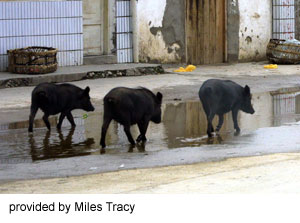Tibetan Swine
 The Tibetan on the Qinghai-Tibet Plateau is especially adapted to the high, cold climate
and to being on pasture all year round. It is characterized by:
The Tibetan on the Qinghai-Tibet Plateau is especially adapted to the high, cold climate
and to being on pasture all year round. It is characterized by:
- Light body weight (about 35 kg in mature animals.)
- Alertness in running and jumping, with quick responses for guarding against attach from other animals.
- Narrow head and long straight snout, to facilitate searching for feeds under the ground.
- Black hair coat, with long and dense bristles (length cm, about 2 to 3 times longer than other breeds) which protect it from the three times as dense as in Sichuan native pigs) which protect it from the strong solar radiation of ultra-violet rays and also from the cold weather on the plateau.
- Highly developed digestive organs; the length of the intestine is about 36 times its own body length (in Sichuan pigs, the intestine is only 28 times its body length). This is presumably a mechanism responsible for the pig's ability to utilize shrubs as feed, as well as the stems, roots and hard seeds of wild plants.
- Ability to deposit fat in the body. The internal and visceral fat is about 15 percent of bodyweight (for other pig breeds, 7 to 10 percent).
- Muscles with a marble appearance and meat with a special flavor.
- Low prolificacy, with a litter size of 5, weaning percent of 69, and 5 pair of teats.
References
Cheng, P. (1984) Livestock Breeds of China. Animal Production and Health Paper 46 (E, F, S). Publ. by FAO, Rome, 217 pp.
Mason, I.L. World Dictionary of Livestock Breeds. Third Edition. C.A.B. International. 1988
